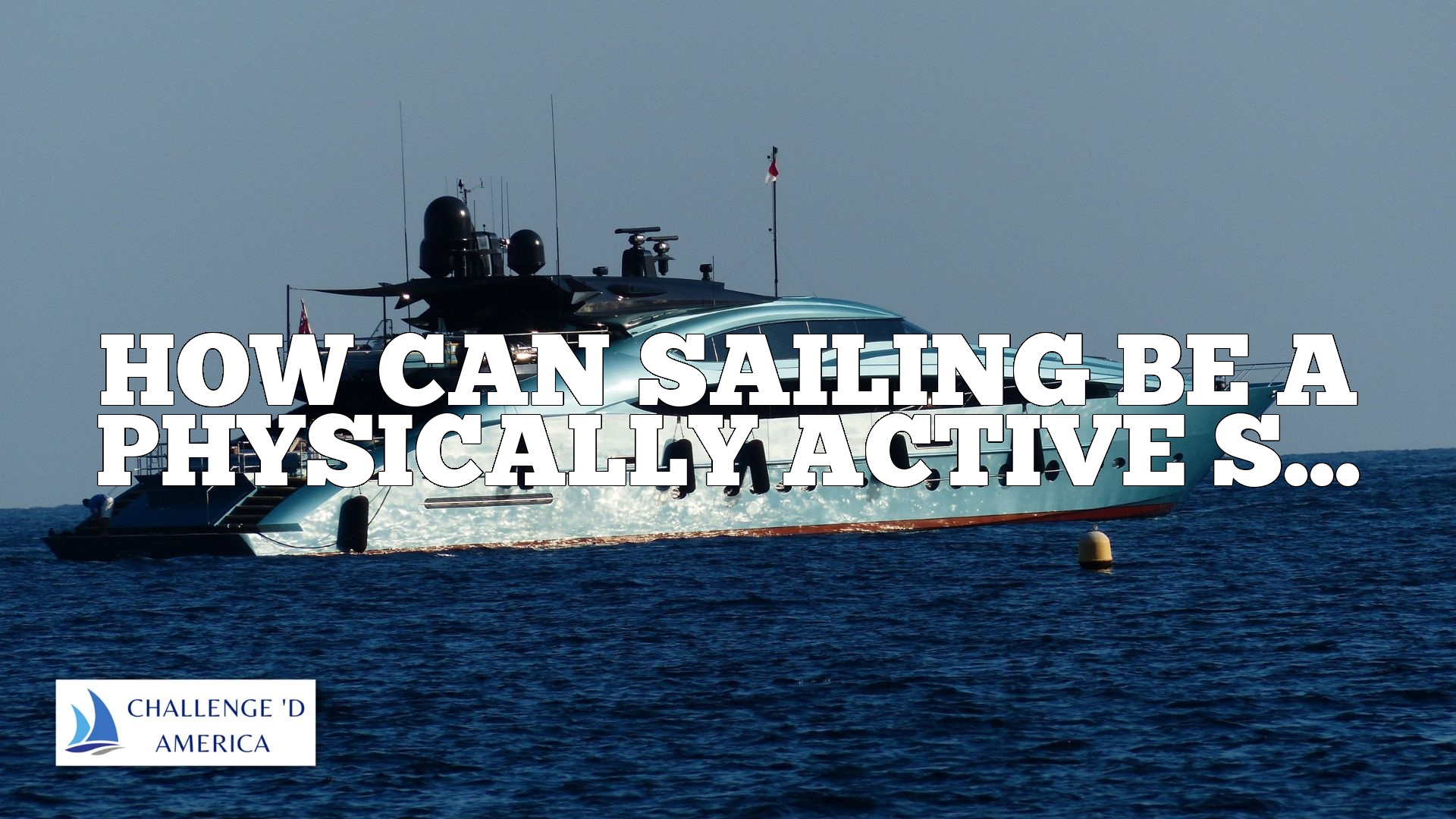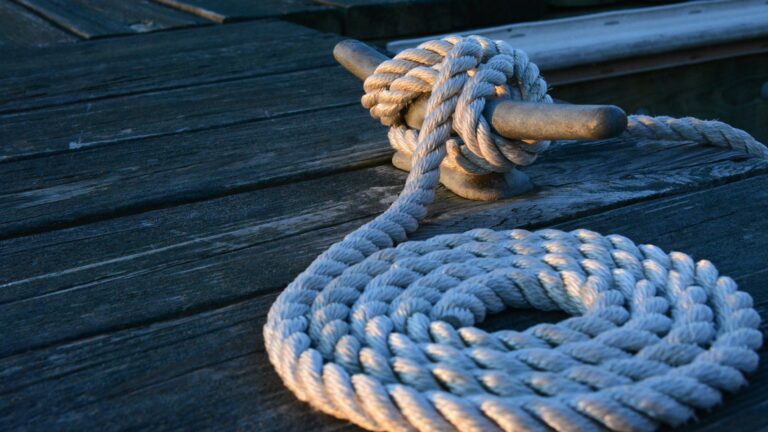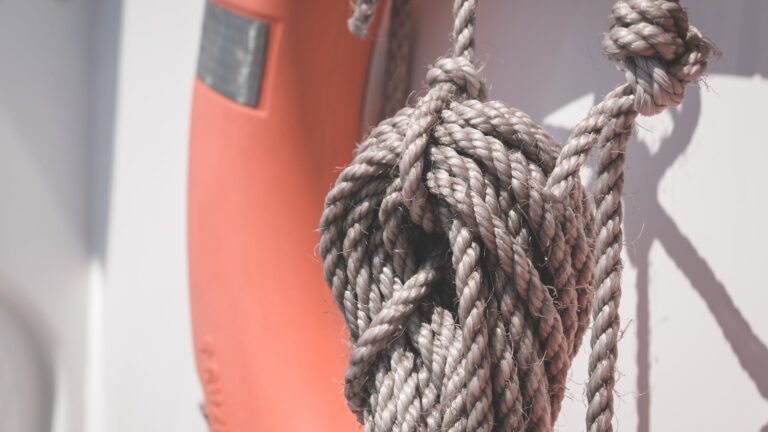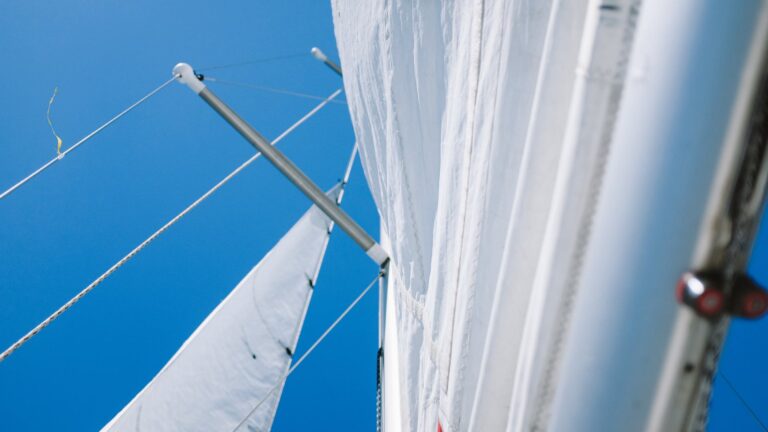How Can Sailing Be A Physically Active Sport?
As an avid sailor, I know firsthand that sailing is an incredibly physically active sport. From reefing sails and adjusting sheets, to tacking and jibing, sailors are constantly on the move and must remain agile in order to keep their vessel moving optimally.
It requires both physical strength and mental agility to ensure that the boat is turning the most efficiently and quickly.
In the following article, I will explore why sailing is such a physically demanding sport, and how it can be used as a form of exercise.
Benefits Of Sailing As A Physical Activity
Sailing is a highly physical activity, as it requires strength and endurance throughout the duration of the sailing session. The physical strain of addressing the wind and waves makes for an excellent upper body and core workout.
Sailing also offers a great cardiovascular workout. The physical labour of manoeuvring the sails and tacking the vessel can burn up to 500 calories per hour. It has been proven to be one of the best activities to help improve overall heart health.
The core muscles get a great workout as the sailor must constantly adjust the angle of the sails to make sure they are optimally utilising the wind power.
In order to keep the boat steady on course and balanced, the sailor must continually adjust their balance as the ocean swell moves the boat from side to side.
The act of sailing also necessitates the use of both upper and lower body strength. The sailor must use their arms and legs to move the sails, rudder, and lines.
This is an excellent full body workout for anyone looking for a physical activity to supplement their exercise routine.
Sailing is a great physical exercise with numerous benefits. Not only does it offer an excellent aerobic and core workout, it also helps develop muscle strength and balance.
In addition to the physical benefits, sailing offers an exciting and unique atmosphere on the open water that can’t be replicated on land.
A. Cardiovascular Health
Sailing as an activity has great benefits for cardiovascular health. As an aerobic exercise, sailing requires sailors to use their whole body, involving both large and small muscle groups.
This helps to increase heart rate, circulation and oxygen delivery to the body, which can help to reduce the risk of cardiovascular diseases.
In particular, the sail trimming and boat handling involved in sailing can really give the cardiovascular system a workout.
Doing so improves the stamina and endurance of the sailor, enabling them to maintain a more consistent and efficient performance on the water.
Additionally, sailing is a great way to build core strength and enhance coordination, as sailing requires a sailor to constantly adjust their body position in response to the constantly changing environment and conditions of the water.
This in turn helps to develop the balance and agility of the sailor, which can help to reduce the risk of injury.
Finally, sailing can be a great way to relax and reduce stress. By being immersed in the environment and focusing on the task at hand, sailors can switch off from the distractions of everyday life and enjoy the moment.
This can have a positive effect on both their physical and mental wellbeing, helping to reduce stress and improve overall cardiovascular health.
B. Strength Training
Strength training is an important part of sailing, as it allows sailors to control and manoeuvre their boat in any weather condition. Strength training can be done on the water or on land and should be consistently included in a sailor’s exercise routine.
Strength training exercises like squats, lunges, planks, and abdominal crunches, help to build and maintain a strong core to ensure that the sailor can maintain good posture and balance when sailing.
Additionally, strengthening the arms and shoulders with exercises like push-ups, overhead presses, and tricep dips help maintain upper body power and endurance when hoisting and trimming sails.
In addition to strength training, sailors should also focus on developing good flexibility and range of motion exercises, such as stretching and yoga.
These types of exercises help keep muscles and joints limber, which helps with controlling the boat and avoiding muscle soreness after a day of sailing.
For sailors who have access to a boat, it is a great way to incorporate strength training into your sailing routine. Weighted deck exercises, such as lifting an anchor or moving a heavy stack of sails, are a great way to build strength.
Additionally, using the boat’s winches and sail trim to work the arms and shoulders is an excellent way to develop the upper body muscles needed for sailing.
Overall, strength training is essential for a successful sailing experience. By engaging in a strength training program that is tailored to your sailing needs, you will find yourself with more power, better balance, and improved control of your boat.
C. Balance and Coordination
Sailing requires excellent balance and coordination. A sailor must be able to sense the subtle shifts in the position of the boat and their own body movements in order to make adjustments in response.
As the boat pitches and rolls, the sailor must stay balanced to remain in control. The coxswain or helmsman must also continually assess the wind and the waves to maintain the boat’s course, making course corrections as needed.
The ability to balance and coordinate can be improved through practice. When sailing, it is important to be aware of one’s centre of gravity and adjust accordingly.
Heeling and trimming the sails will also help with balance. When sailing upwind, the sailor should shift their weight forward, while sailing downwind requires one to move their weight aft. This can be difficult to master, but it will become easier with practice.
The skill of balancing and coordinating can also be improved by learning the fundamentals of sailing, such as understanding the relationship between the sail and wind, and how the sail needs to be adjusted to optimize the boat’s speed and direction.
Being able to read and understand the wind is a critical component of sailing, which can be done through practice and experience.
By learning and understanding the principles of sailing, sailors can develop the coordination and balance needed to stay in control and enjoy a safe, successful sailing experience.
D. Mental Health Benefits
Sailing can have a profound effect on one’s mental health. While the physical activity is what initially attracts many people to the sport, it is actually one’s mental state that is improved in the most dramatic fashion.
It is often said that sailing offers a mental freedom, a connection to nature, and a sense of inner peace that no other sport can replicate.
The vastness of the ocean, combined with the sounds of the wind and waves, can provide a sense of calm and tranquillity that is essential to reducing stress and anxiety.
Focusing on the task at hand, whether it be the navigation of the boat or the performance of the sails, can help to clear the mind and reduce stress.
Additionally, the sense of accomplishment that comes with successfully maneuvering a boat can boost one’s self-confidence and self-esteem.
Sailing also requires a great level of concentration, and as a result, can help to focus the mind. This ability to stay present and focused on the task at hand can help to improve one’s mental clarity and well-being.
Finally, the camaraderie found among sailors is one of the most endearing aspects of the sport. Working together as a team to maneuver the boat and conquer the elements can create a strong sense of community and kinship that is often lacking in our modern world.
This supportive community of peers can help to provide a sense of belonging and contentment that can be greatly beneficial to one’s mental health.
In summary, sailing can offer a wide range of mental health benefits that can help to reduce stress, improve mental clarity, and boost self-confidence.
The sense of community and tranquillity that can be found on the open seas is unique to sailing, making it a fantastic choice for those looking to improve their mental health.
Tips For Getting Started
Getting started with sailing is an exciting journey, but it can be a bit daunting at first! Here are some tips to help you get started:
- Learn the Basics: Before you set sail, be sure to familiarize yourself with the key sailing terms and concepts, such as understanding the points of sail, tack and jibe, sheeting in and out, heaving to, and reefing.
- Choose the Right Boat: Different types of boats are designed for different purposes. Generally, sailing dinghies and keelboats are good for recreational sailing, while performance boats are designed for racing. Make sure to choose the right boat for your level of experience, and consider taking a boat handling course.
- Get the Right Gear: As with any sport, having the right gear is essential. Make sure you have the appropriate clothing for sailing, such as a windbreaker and non-slip shoes. If you’re sailing in a dinghy, you’ll need a PFD and harness. You’ll also need a variety of safety equipment, such as flares, a VHF radio, and a toolkit.
- Join a Club: Joining a sailing club is a great way to get involved in the sailing community and learn from experienced sailors. Most sailing clubs offer classes and workshops for beginners, and can be a great place to meet fellow sailors and make new friends.
Happy sailing!
A. Find A Local Sailing Club
For those interested in getting out on the water, the first step is to find a local sailing club. Many local sailing clubs are affiliated with the national governing body of sailing, the United States Sailing Association (US Sailing).
US Sailing certified instructors can be found at most sailing clubs and can help new sailors learn the basics, as well as how to safely and confidently sail on their own.
Clubs also often offer rental boats, social events, and racing opportunities. If a person is interested in racing, it is important to find a club that hosts various levels of sailing competitions.
When looking for a sailing club in your area, it is important to research the qualifications of the instructors, cost of membership, and availability of boats for rent. Additionally, it is important to understand the type of sailing that your local sailing club specializes in.
The main categories of sailing are Dinghy, Kite, and Cruising. Dinghy sailing is fast-paced and designed for racing and maneuvering around buoys. Kite sailing combines sailing with kiteboarding and is appealing to many younger sailors.
Cruising is a slower-paced form of sailing, which involves sailing a boat over a longer distance and is commonly used for recreational sailing trips.
B. Take A Sailing Course
For those looking to get started in sailing, a sailing course is a great way to learn the basics. The key to sailing safely and confidently is having the right knowledge and training. Sailing courses can provide the perfect foundation for a lifetime of sailing enjoyment.
Sailing courses typically cover topics such as the parts of a sailboat, rigging, knots, sail trim, steering, sailing terminology, navigation rules, and weather. Knowledge and understanding of these topics is essential for any sailor wanting to sail safely and confidently.
Most sailing instructors also focus on teaching the fundamentals of physical sailing skills such as tacking, jibing, and mainsail trim. These practical sailing skills are important for developing the confidence and ability needed to become an independent sailor.
Sailing courses are available for all levels of experience, from beginner to advanced. They can be taken through a sailing school or on a private boat with an instructor.
They can also be taken as part of a club or organization, such as the U.S. Coast Guard Auxiliary, the Boy Scouts of America, or the American Sailing Association.
By taking a sailing course, sailors can gain the knowledge and skills necessary to make them safe, confident, and capable sailors. With the right knowledge and training, sailing can become a physically active and enjoyable sport.
C. Practice Safety
When participating in the sport of sailing, safety should always be the priority. The importance of sailing safety cannot be overstated, as it is essential to protect not just yourself, but also your crew. There are several key points to consider when heading out onto the water.
First, always wear protective clothing and gear, such as a life jacket, a personal flotation device, and an appropriate flotation suit.
Make sure all crew members are familiar with the boat and its equipment. Ensure that all safety equipment is functioning and in good condition. This includes flares, first aid kits, and a working radio.
It is also important to be aware of the weather conditions, and ensure the boat is prepared for any unexpected changes. Ensure that the boat is stocked with enough food, water, and fuel for the voyage. Lastly, become familiar with the local boating laws, and be sure to obey them.
By following the basic safety precautions listed above, any sailor can ensure that they have the best and most fun possible while sailing.
D. Learn Basic Navigation
Navigation is one of the most important skills to learn in the sport of sailing. It is the process of planning and tracking your course, as well as being able to identify and safely navigate around obstacles in the water.
There are a few essential elements to sailing navigation that must be mastered in order to safely and successfully sail.
First, a sailor must understand the basic terminology used in navigation. These terms include: “course” which is the chosen path to take; “waypoint” which is a point on the chart that signals a turning point; “bearing” which is the direction to be taken; “heading” which is the direction of the boat relative to the wind; and “tack” which is the zig-zag pattern used to sail up-wind.
Second, a sailor must understand the basics of chart navigation. This involves learning how to read a chart and identify landmarks, buoys and other navigation markers.
A sailor also must be able to distinguish daymarks, which are bright colored buoys, from nightmarks, which are black and white buoys.
Third, a sailor must understand the basics of dead reckoning navigation. Dead reckoning navigation is the process of calculating a course by plotting a course on a chart and then estimating the time and distance to complete the course.
Estimating the course time and distance is done by factoring in the speed of the boat, the current of the water, and any other environmental factors that may affect the course.
Finally, a sailor must understand the basics of compass navigation. This involves learning how to properly read a compass and how to use the compass to stay on course.
In addition to reading the compass, a sailor must also know how to adjust the compass to account for various weather conditions.
By mastering these basic elements of sailing navigation, a sailor can safely and confidently sail any course. With much practice, a sailor can become a proficient navigator, allowing them to fully enjoy the physical and mental challenge that sailing offers.
Summary: How Can Sailing Be A Physically Active Sport?
Sailing is a fantastic sport to get physically active, as it requires strength and coordination to maneuver the vessel and to control the sails. It is also a great cardiovascular exercise and helps to build core power and muscle endurance.
With the right training and preparation, sailors can maximize the physical activity of the sport by using various techniques, such as manipulating the sails to harness wind power and optimizing the trim of the boat.
Additionally, sailing can improve balance and reaction times through accurate navigation and challenging sailing conditions. All in all, sailing is an incredibly rewarding and physically active sport, and is a great way to stay fit and healthy.
FAQs
What Are The Physical Benefits Of Sailing?
Sailing is a physically active sport that provides a wide range of physical benefits. Not only does it offer an aerobic workout, but it also works out the muscles and develops strength, coordination, and balance.
One of the most obvious physical benefits of sailing is the aerobic workout it provides. Sailing is an aerobic activity that requires sustained physical output, making it an excellent way to burn calories. Additionally, it can help to increase endurance and improve cardiovascular health.
Sailing also works out the muscles throughout the body. Core muscles are used to maintain balance, while arm muscles get a workout from the repetitive tasks involved in sailing. Leg muscles are worked out as well, as they are used to push off and reach for the tiller.
Strength and coordination are also important components of sailing, and they can be developed through regular sailing. This is especially true of strength in the arms, as they are used to control the sails and tiller. Coordination is also essential in sailing, as it helps to keep the boat steady and on course.
Finally, sailing can help to develop balance. This is an important skill for sailing, as it helps to keep the boat upright and on course. Additionally, balance can help to prevent falls and injuries while on the boat.
Overall, sailing is a physically active sport that provides a wide range of physical benefits. It offers an aerobic workout, as well as helping to develop strength, coordination, and balance. In addition, sailing can be a fun and enjoyable way to stay active.
What Type Of Physical Activity Is Involved In Sailing?
Sailing can be a physically active sport depending on the type of sailing you are doing. Generally, there are two types of physical activity involved in sailing – sailing maneuvers and trimming the sails.
Sailing maneuvers involve controlling the boat’s direction by manipulating the sails and the rudder. This requires a good balance of upper body and core strength as well as agility and coordination.
Depending on the size of the boat, sailing maneuvers can be quite strenuous, as you may need to pull the sails up and adjust them to the wind direction.
Trimming the sails is the process of adjusting the sails’ shape to the current wind conditions. This includes the use of various “lines” or ropes to manipulate the sails.
This requires you to pull the lines with a certain strength, which can be quite strenuous and require an excellent level of upper body strength.
In addition to this, sailing also requires a good sense of balance, as you may need to move around the boat to adjust the sails to the wind direction. This also involves using your core and leg muscles to maintain your balance.
Overall, sailing requires a good combination of upper body and core strength, agility and coordination. It is a great way to stay physically active and enjoy the wonders of the ocean.
What Muscles Are Used When Sailing?
Sailing is a sport that engages many of the body’s muscles, and as such can be a great way to stay physically active. Primarily, sailing requires the use of the core muscles, which work together to keep the body stable and balanced while in the boat.
Additionally, the back and abdominal muscles are used to control the sails and the rudder, and the legs and arms are used to support the body while adjusting the sails.
The arms and shoulders are used for both steering the boat and controlling the sails, as the sailor must be able to pull and trim the mainsheet and jib sheets.
The legs and feet are used to brace the body against the boat, which helps to keep it stable and upright in choppy waters.
The act of sailing also requires the use of muscles that are often not used in everyday life. For instance, the muscles in the hands and wrists are used to grip the tiller and mainsheet.
The neck and upper back muscles are used to keep the sailor’s head in the correct position to watch for changing wind and wave conditions.
As a sailing expert, I highly recommend sailing as a great way to get in shape and keep active. With the right instruction and safety gear, sailing can be a fun and rewarding experience that engages the body in ways that many other sports cannot.
How Can Sailing Be Used As A Form Of Exercise?
Sailing is an excellent form of exercise that can provide a challenging yet rewarding workout. It is physically demanding and requires a good level of physical fitness in order to perform well.
Sailing works both the upper and lower body as you use your arms to control the sails and your legs to balance the boat. You will be actively using your core muscles to maintain your balance and posture while you maneuver the boat.
The wind strength and direction can also add an extra layer of challenge to your sailing workout. You will need to adjust your sails and trim the boat to maximize the power of the wind to gain speed. This requires concentration and physical effort to control the boat and make quick decisions. This is a great way to challenge your body and mind.
Sailing can also be combined with other exercises such as stretching and yoga. Stretching can help you to stay flexible and relaxed while sailing, while yoga can improve balance and core strength. These types of exercises can be done on the boat or on shore before and after sailing.
Finally, sailing is a great way to enjoy the outdoors while getting some exercise. You can enjoy the scenery and fresh air while getting your daily workout. You can also enjoy the feeling of freedom as you maneuver the boat around the course and challenge yourself with the changing wind conditions.
In conclusion, sailing is an excellent form of exercise that can provide a challenging workout for both the body and the mind. With some practice, you can develop the skills and physical fitness to enjoy sailing as a healthy and active sport.
How Can Sailing Be Used To Improve Physical Fitness?
Sailing is an extremely physically active sport, and can be used to improve physical fitness in a number of ways.
Firstly, sailing requires a good level of cardiovascular fitness. By tacking, jibing and trimming sails, a sailor needs to be able to move around the boat quickly and efficiently to make the most of the wind. This requires strength, balance and endurance, all of which can be improved through regular sailing.
Secondly, sailing requires a good level of muscular fitness. A sailor needs to be able to pull on the sheets and halyards to set and adjust sails, as well as to raise and lower them. This requires a good level of upper body strength and stamina, which can be improved through regular sailing.
Finally, sailing can help to improve balance and coordination. In order to sail effectively, a sailor needs to be able to move around the boat in a coordinated and efficient manner, which can help to improve balance and coordination.
In summary, sailing can be used to improve physical fitness in a number of ways, including cardiovascular fitness, muscular fitness and balance and coordination. Regular sailing can help to improve a sailor’s physical fitness, making them a more effective and efficient sailor.
What Are The Best Sailing Exercises For Physical Fitness?
Sailing is a great way to stay physically fit. There are a variety of sailing exercises that can help you stay in shape and improve your sailing performance.
Here are some of the best sailing exercises that you can incorporate into your routine:
- Core Strength: Core strength is essential for any sailor as it helps to maintain balance and control when out on the water. Exercises such as planks, sit-ups, and Pilates can help to strengthen your core muscles and improve your sailing performance.
- Cardio: Cardio is important for any physical activity, and sailing is no exception. Incorporate exercises such as running, biking, or swimming into your routine to help build endurance and stamina.
- Upper Body Strength: Upper body strength will help you control the sails, as well as helping you stay balanced on the boat. Workouts such as push-ups, pull-ups, and shoulder presses will help to build your strength and improve your sailing performance.
- Balance: Balance is essential when sailing, as it helps you stay steady in the boat and maintain control of the sails. Incorporate exercises such as yoga and tai chi into your routine to help build balance and coordination.
Overall, there are a variety of sailing exercises that you can incorporate into your routine to help improve your physical fitness and sailing performance. Be sure to consult with a professional sailing instructor to ensure that you are doing the exercises correctly and safely.
Sailing can be a physically active sport when done correctly. It requires strength, endurance, and agility to maneuver the boat through the water, as well as to hoist the sails and trim them to the wind. The physicality of sailing can vary depending on the type of boat, the size of the sails, and the skill of the sailor.
On smaller boats, such as dinghies and keelboats, sailing can be very physically demanding. The sailor is responsible for adjusting the sails to the wind, steering the boat, and managing the crew.
All of these tasks require strength and agility, as well as good communication skills. In addition, tacking and jibing require the sailor to move quickly around the boat, and trimming the sails requires fine motor skills.
On larger boats, the physicality of sailing is reduced, as the sails can be adjusted with winches and the boat is steered from the helm. However, these boats still require sailors with good physical fitness, as they must be able to maneuver the boat in strong winds and rough water.
Sailing can also be physically demanding for those who take part in racing. Racers must be in top physical condition in order to be competitive. They must be able to make quick decisions, adjust the sails to the wind, and maneuver the boat around the course as quickly as possible.
Overall, sailing is a physically active sport that requires strength, endurance, and agility. Those who are physically fit and have good sailing skills will have the most success on the water.







